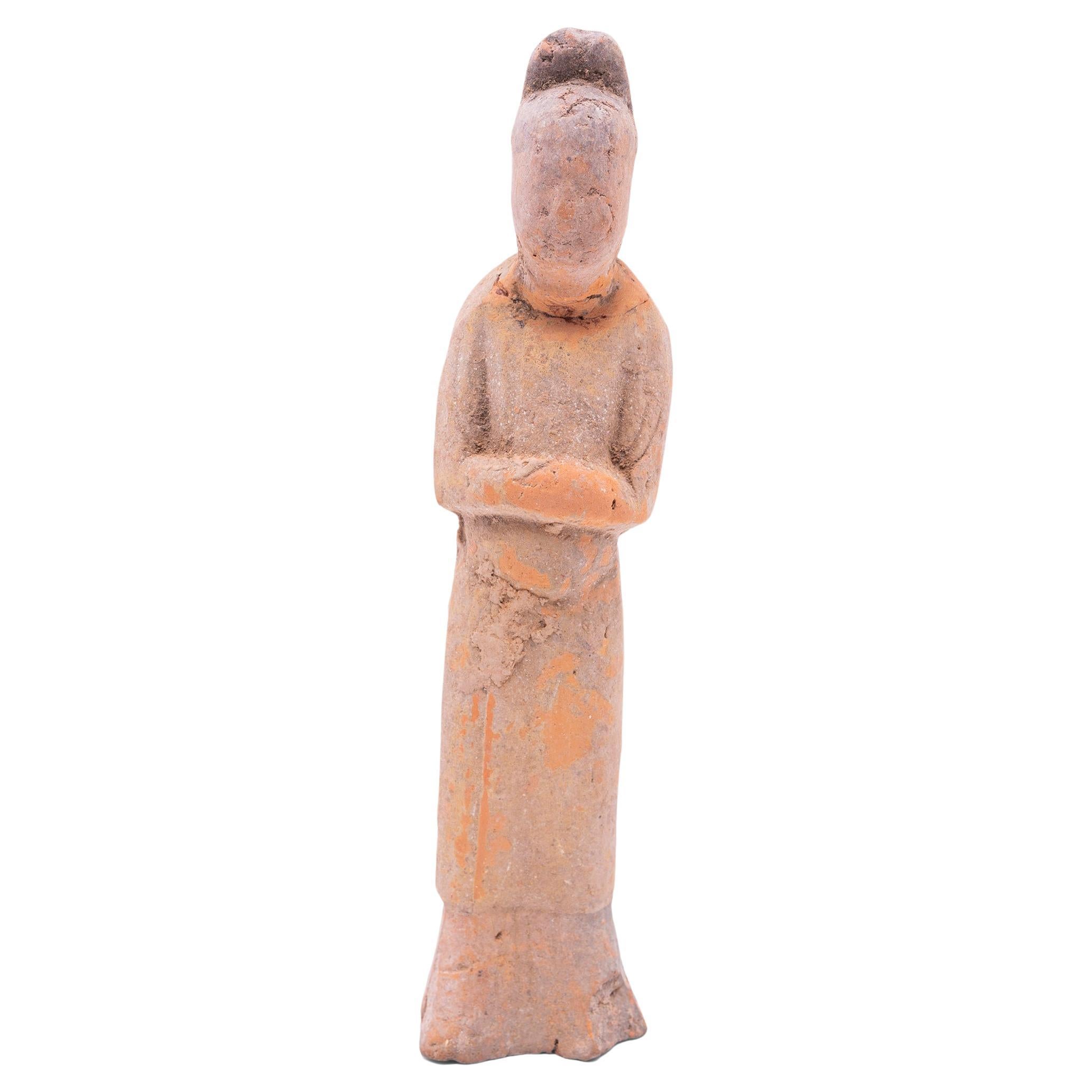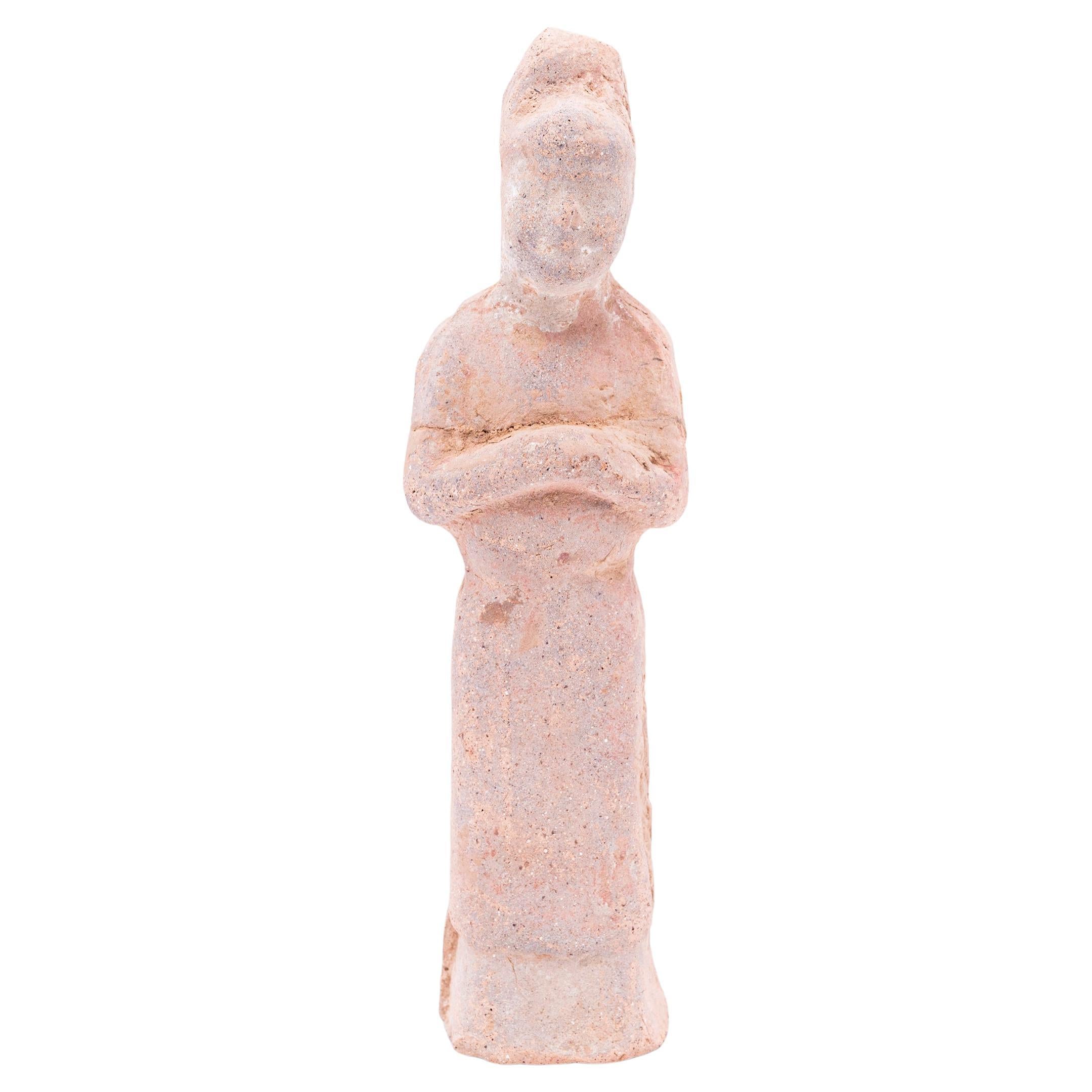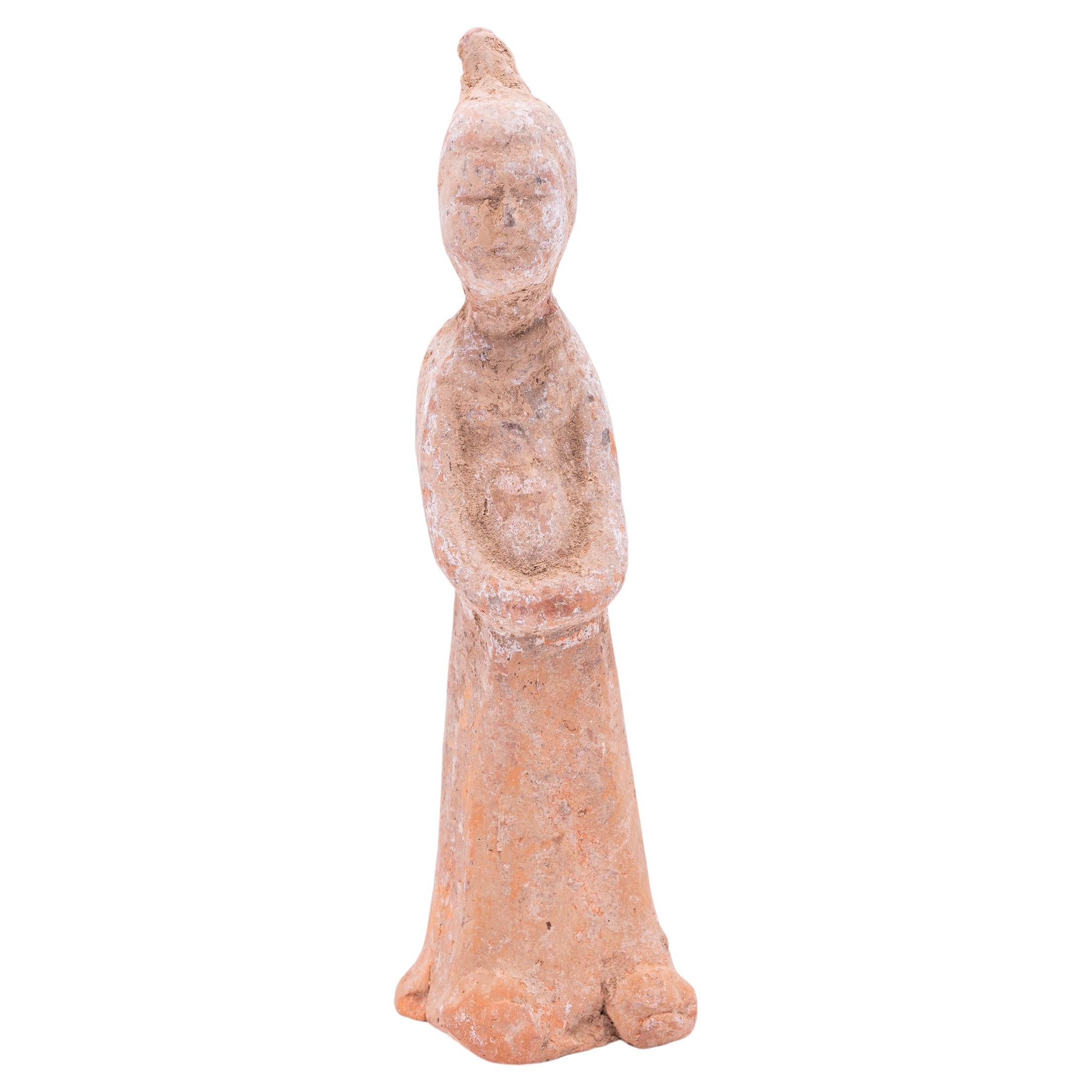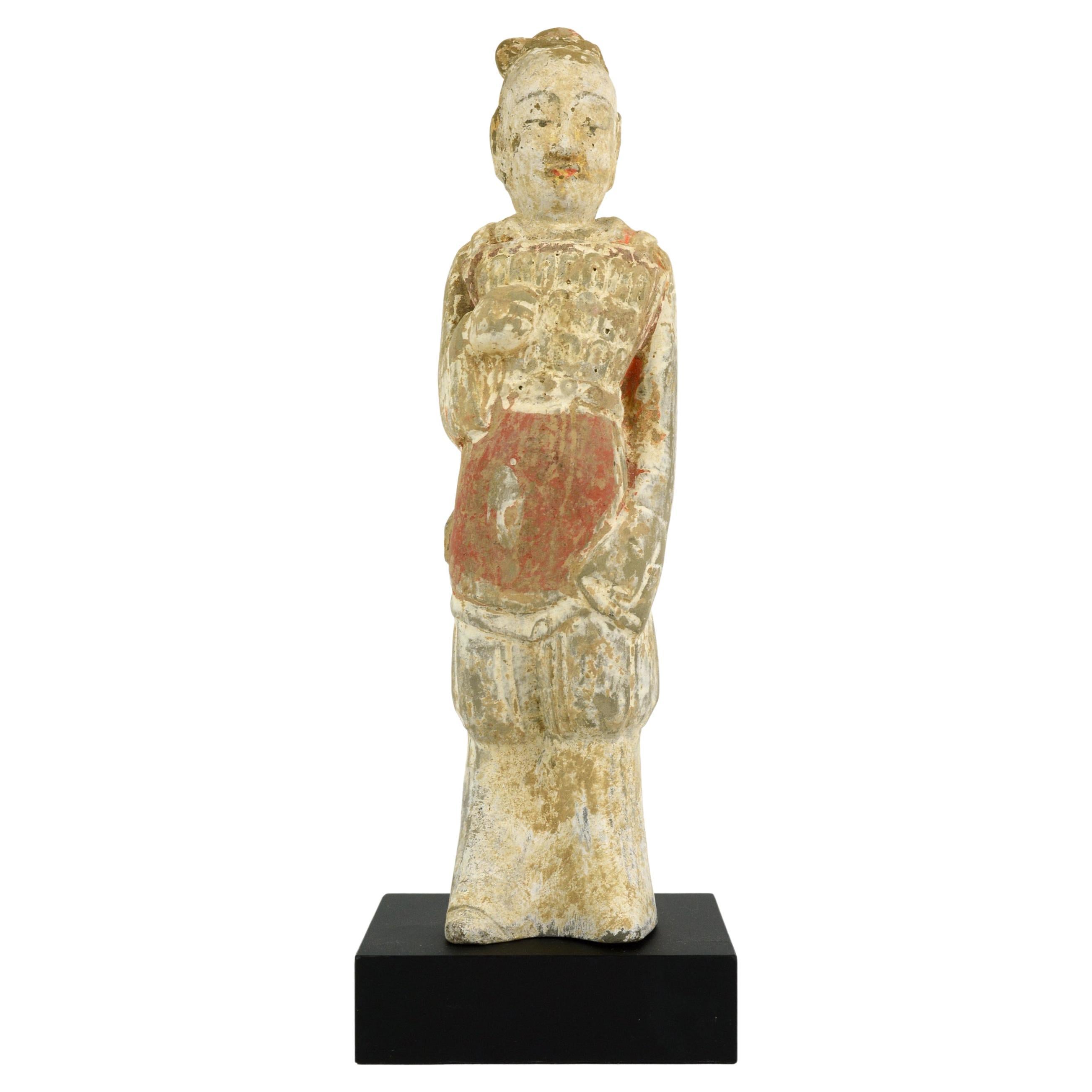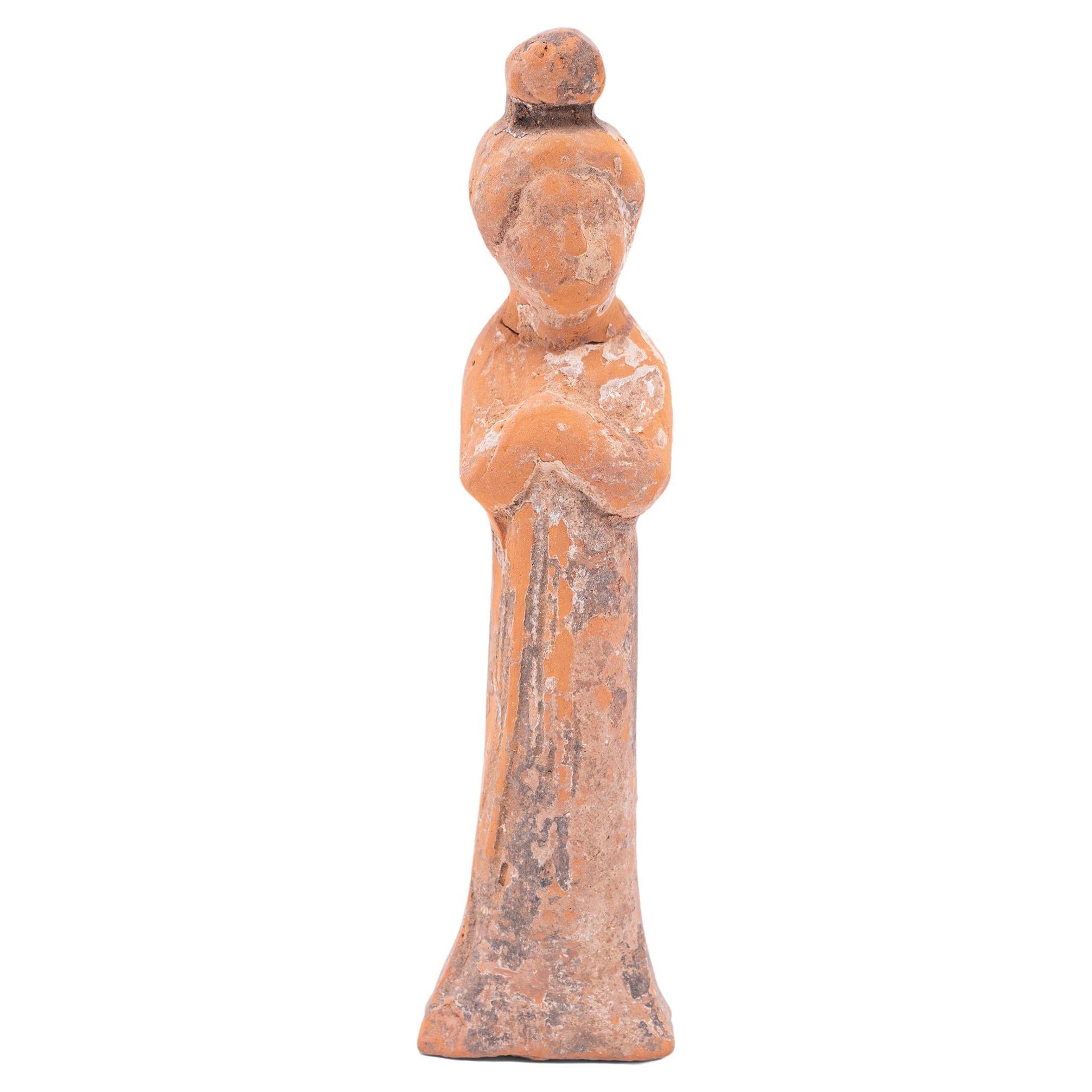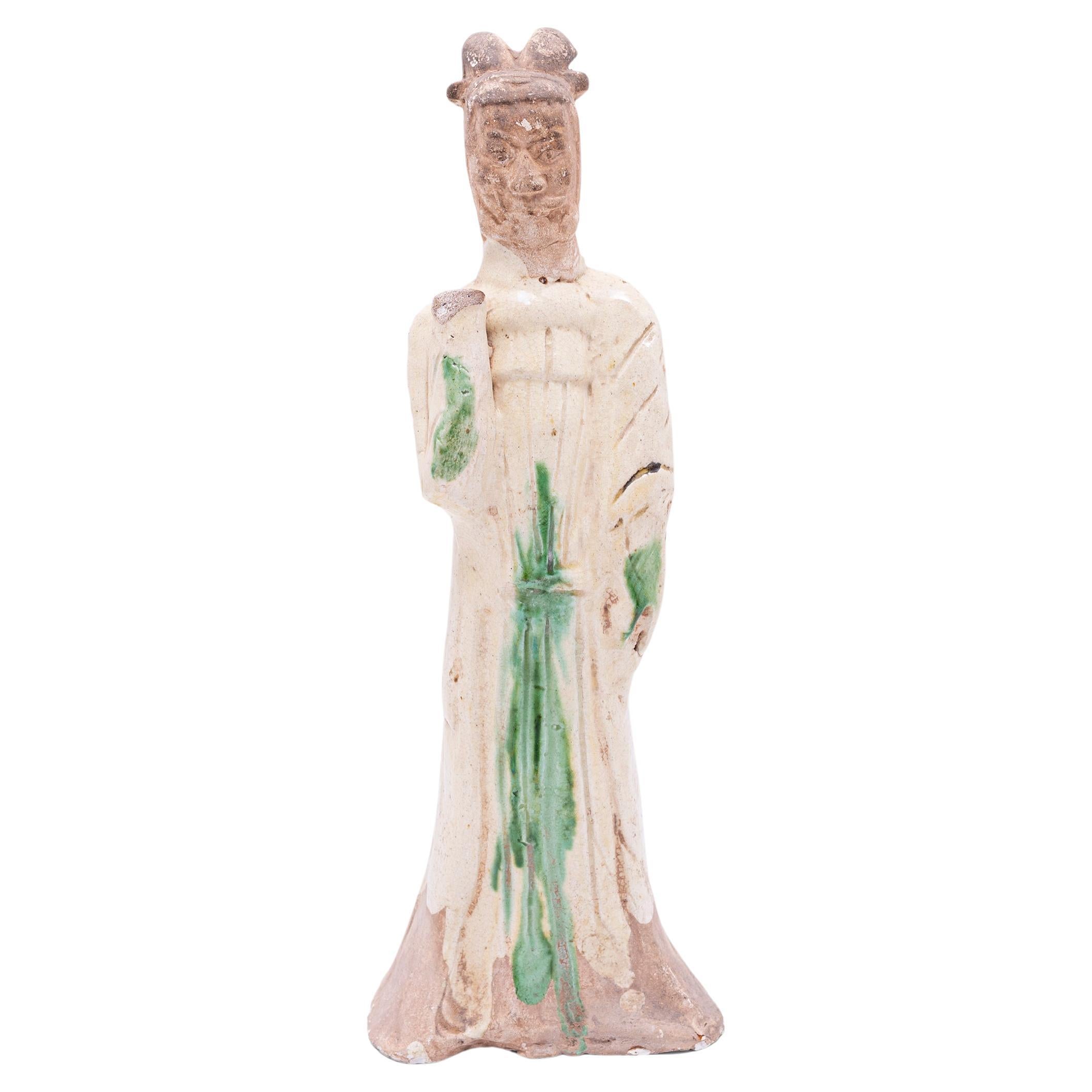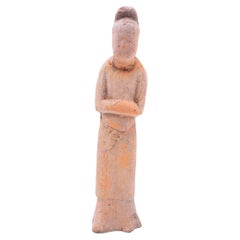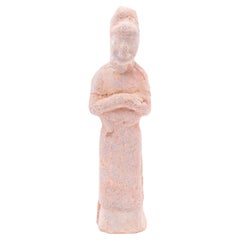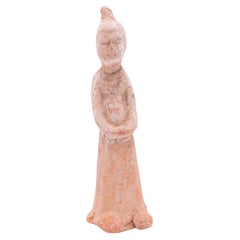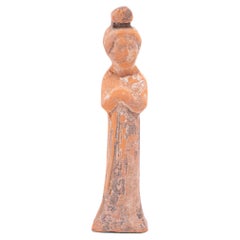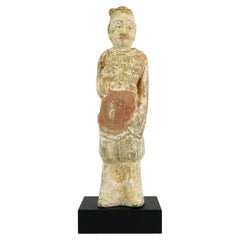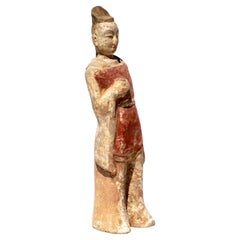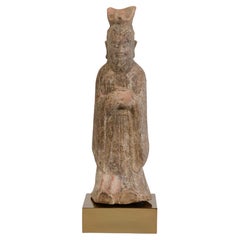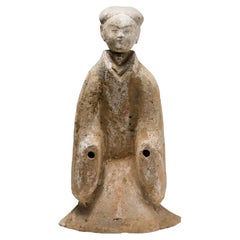Items Similar to Chinese Male Mingqi Spirit Attendant
Want more images or videos?
Request additional images or videos from the seller
1 of 6
Chinese Male Mingqi Spirit Attendant
$580
£435.71
€502.45
CA$804.83
A$894.34
CHF 468.64
MX$10,967.47
NOK 5,977.27
SEK 5,623.20
DKK 3,750.05
Shipping
Retrieving quote...The 1stDibs Promise:
Authenticity Guarantee,
Money-Back Guarantee,
24-Hour Cancellation
About the Item
Molded of earthenware, this petite sculpture is a type of centuries-old burial figurine known as míngqì. Such model figures were placed in tombs of individuals with high status to ensure a safe journey to the afterlife. Meant to depict the pleasures of daily life, common burial figures were warriors, dancers, male and female figures and animals.
This míngqì is of a male attendant dressed in a long gown, hands folded in front and topped by a towering coiffure or headdress. The sculpture is coated with a pale glaze and has now weathered from age, revealing the original ceramic form.
The front of the headdress has chipped off.
- Dimensions:Height: 8.75 in (22.23 cm)Width: 2.25 in (5.72 cm)Depth: 1.75 in (4.45 cm)
- Materials and Techniques:
- Place of Origin:
- Period:
- Date of Manufacture:Unknown
- Condition:Wear consistent with age and use. Minor losses. Minor structural damages.
- Seller Location:Chicago, IL
- Reference Number:Seller: CESB0451stDibs: LU820036268992
About the Seller
5.0
Platinum Seller
Premium sellers with a 4.7+ rating and 24-hour response times
Established in 1997
1stDibs seller since 2006
1,693 sales on 1stDibs
Typical response time: <1 hour
- ShippingRetrieving quote...Shipping from: Chicago, IL
- Return Policy
Authenticity Guarantee
In the unlikely event there’s an issue with an item’s authenticity, contact us within 1 year for a full refund. DetailsMoney-Back Guarantee
If your item is not as described, is damaged in transit, or does not arrive, contact us within 7 days for a full refund. Details24-Hour Cancellation
You have a 24-hour grace period in which to reconsider your purchase, with no questions asked.Vetted Professional Sellers
Our world-class sellers must adhere to strict standards for service and quality, maintaining the integrity of our listings.Price-Match Guarantee
If you find that a seller listed the same item for a lower price elsewhere, we’ll match it.Trusted Global Delivery
Our best-in-class carrier network provides specialized shipping options worldwide, including custom delivery.More From This Seller
View AllChinese Male Mingqi Spirit Attendant
Located in Chicago, IL
Molded of earthenware, this petite sculpture is a type of centuries-old burial figurine known as míngqì. Such model figures were placed in tombs of individuals with high status to ensure a safe journey to the afterlife. Meant to depict the pleasures of daily life, common burial figures...
Category
Antique 15th Century and Earlier Chinese Chinese Export Antiquities
Materials
Ceramic
Chinese Male Mingqi Spirit Attendant
Located in Chicago, IL
Molded of earthenware, this petite sculpture is a type of centuries-old burial figurine known as míngqì. Such model figures were placed in tombs of individuals with high status to ensure a safe journey to the afterlife. Meant to depict the pleasures of daily life, common burial figures...
Category
Antique 15th Century and Earlier Chinese Antiquities
Materials
Ceramic
Chinese Female Mingqi Spirit Attendant
Located in Chicago, IL
Molded of earthenware, this petite sculpture is a type of centuries-old burial figurine known as míngqì. Such model figures were placed in tombs of individuals with high status to en...
Category
Antique 15th Century and Earlier Chinese Figurative Sculptures
Materials
Earthenware
Chinese Female Mingqi Spirit Attendant
Located in Chicago, IL
Molded of earthenware, this petite sculpture is a type of centuries-old burial figurine known as míngqì. Such model figures were placed in tombs of individuals with high status to en...
Category
Antique 15th Century and Earlier Chinese Figurative Sculptures
Materials
Earthenware
Sancai Mingqi Spirit Attendant
Located in Chicago, IL
Molded of earthenware, this petite sculpture is a type of centuries-old burial figurine known as míngqì. Such model figures were placed in tombs of individuals with high status to ensure a safe journey to the afterlife. Meant to depict the pleasures of daily life, common burial figures...
Category
Antique 15th Century and Earlier Chinese Chinese Export Antiquities
Materials
Ceramic
Chinese Yellow Glazed Mingqi Spirit Scholar
Located in Chicago, IL
Molded of earthenware, this petite sculpture is a type of centuries-old burial figurine known as míngqì. Such model figures were placed in tombs of individuals with high status to ensure a safe journey to the afterlife. Meant to depict the pleasures of daily life, common burial figures...
Category
Antique 15th Century and Earlier Chinese Antiquities
Materials
Ceramic
You May Also Like
Eastern Wei Soldier
Located in Santa Monica, CA
Eastern Wei Soldier 9.5h
An unglazed figure of a soldier. This figure sits on a base which measures 1h x 3.25d x 3.75w (inches).
Red Pottery Origin: He...
Category
Antique 15th Century and Earlier Chinese Sculptures and Carvings
Materials
Terracotta
Chinese Northern Wei Terrecotta Attendant - TL Tested
Located in Dallas, TX
Circa 386-534 ADA well defined Chinese Northern Wei Terracotta Attendant Statue.
The Figure is depicted standing with his hands along the body, wearin...
Category
Antique 15th Century and Earlier Chinese Tang Figurative Sculptures
Materials
Terracotta
Northern Qi Dynasty, Antique Chinese Pottery Standing Court Man
Located in Sampantawong, TH
Antique Chinese pottery standing court man.
Age: China, Northern Qi Dynasty, A.D. 550 - 577
Size of figure only: Height 29.8 C.M. / Width 9 C.M.
Height including stand: 33.8 C.M.
Co...
Category
Antique 15th Century and Earlier Chinese Antiquities
Materials
Pottery
$1,480 Sale Price
20% Off
Large Pottery Standing Figure of Attendant, Han dynasty
Located in seoul, KR
This artwork, acquired in Hong Kong during the 1990s, is presumed to have been produced in the same kiln from the Han dynasty, based on the head of the Sotheby's reference piece, which also originated from Hong Kong. Furthermore, given its almost identical shape to the piece from the Artemis Gallery...
Category
Antique 15th Century and Earlier Hong Kong Han Antiquities
Materials
Pottery
$3,213 Sale Price
30% Off
Han Dynasty, Antique Chinese Pottery Attendant Figurine
Located in Sampantawong, TH
Chinese pottery attendant figurine.
Age: China, Han Dynasty, 206 B.C. - A.D. 220
Size: Height 22 C.M. / Width 12 C.M.
Condition: Well-preserved old burial condition overall.
100% s...
Category
Antique 15th Century and Earlier Chinese Antiquities
Materials
Pottery
$1,800 Sale Price
20% Off
A Han Dynasty Terracotta Figure
Located in Chicago, IL
A large Chinese terracotta tomb figure (Ni Yong) from the Eastern Han Dynasty (25-220 AD), likely from the area of modern-day Sichuan. It appears to depict a groom in full costume an...
Category
Antique 15th Century and Earlier Chinese Antiquities
Materials
Terracotta
$12,600 Sale Price
30% Off
More Ways To Browse
Maling China
Antique Chinese Earthenware
Chinese Figurines
Chinese Tomb
Antique Chinese Coat
Chinese Ceramic Figures
Chinese Warrior
Chinese Female Figures
Antique Chinese Figurines
Female Warrior
Chinese Glazed Figurine
Chinese Warrior Sculpture
Chinese Headdress
Chinese Ceramic Figurine
Asian Warrior Sculpture
Chinese Ceramic Warrior
Tomb Attendant
Vintage Japanese Haori
